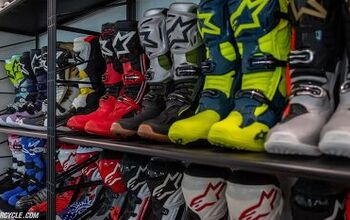2000 Bultaco Sherco - Motorcycle.com
Get the Flash Player to see this player.
"What's that you say? It's supposed to be like that? Well, OK. But the tires are flat, too. Really? They're supposed to be that low? Well, the seat fell off, anyhow. Oh, wait, don't tell us..."
Bultaco's Sherco is made for trials. No, it has nothing to with Johnny Cochran and the multitude of injustices being perpetrated upon the millions of downtrodden so and so the world over; the kind of trials we're talking about involve riding a
Confused yet? Join the club.
Having never thrown a leg over anything like this Bultaco before, we never knew what to expect. The 250 cc two-stroke motor gets its displacement through a traditionally-sized 72.8 x 60 mm bore and stroke and is fed by a single 26 mm Del 'lorto carburetor. To get extra grunt and to avoid stalling a two-stroke motor that runs at comparatively low RPMs, a balanced magnetic Flywheel larger than most Waffle House pancakes is attached within the cases.
The motor is housed in a frame made of chrome molybendum alloy steel and the swingarm is manufactured from aluminum alloy. Attached to the rear of the swingarm are eccentric chain adjusters and a single floating 145 mm solid disc which is squeezed by a twin piston AJP caliper. The rear end moves through 170 mm of travel thanks to a progressive Olle' monoshock. The front brake is a single floating 185 mm unit which is squeezed by a double piston AJP caliper that hangs at the bottom of a Paioli telescopic fork with 170 mm of travel. The front wheel is a 21-incher while the rear hoop checks in at 18-inches in classic dirtbike style.
As for us riding the bike? We are so not worthy of being in its presence. Trials Champions like Geoff Aaron and Ryan Young can do things on bikes like this that, should you ever be lucky enough to witness firsthand, boggle the mind.
If you get the opportunity to ride a trials bike, don't pass it up. We may have just found the ultimate play bike and a whole lot more.
More by Motorcycle Online Staff




































Comments
Join the conversation